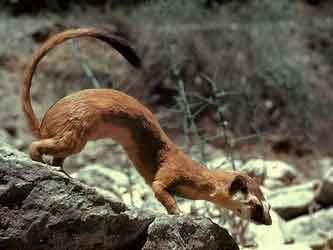Subclass Theria Order Carnivora Scientific name Mustela felipei Higher classification Weasel Length 22 cm (Adult) | Phylum Chordata Infraclass Eutheria Mass 120 – 150 g (Adult) Rank Species Tail length 12 cm (Adult) | |
 | ||
Similar Indonesian mountain weasel, Amazon weasel, Back‑striped weasel, Malayan weasel, Patagonian weasel | ||
Mustela colombian weasels comadreja gattung amazing mammals
Colombian weasel (Mustela felipei), also known as the Don Felipe's weasel, is a very rare species of weasel only known with certainty from the departments of Huila and Cauca in Colombia and nearby northern Ecuador (where only known from a single specimen). Both its scientific and alternative common name honours the mammalogist Philip "Don Felipe" Hershkovitz.
Contents
- Mustela colombian weasels comadreja gattung amazing mammals
- Geographic range
- Habitat
- Physical appearance
- Diet
- Conservation status
- References
It appears to be largely restricted to riparian habitats at an altitude of 1,100 to 2,700 m (3,600 to 8,900 ft). There is extensive deforestation within its limited distribution within the northern Andes of Colombia and Ecuador, and with less than ten known specimens, it is probably the rarest carnivoran in South America. It is considered vulnerable by the IUCN.
It is the second smallest living carnivore on average, being only slightly larger than the least weasel (Mustela nivalis) and slightly smaller than the ermine or stoat (M. erminea). The upperparts and tail are blackish-brown, while the underparts are orange-buff.
Geographic range
M. felipei is one of the least studied carnivore species in the Americas, and is expected to maintain a larger geographical range that currently known. Reports of sightings have placed M. felipei in the mountain ranges of western Colombia to northern Ecuador. M. felipei was originally thought to be endemic to Colombia however recent specimens have been collected in Ecuador that have since proven this thought wrong. Distribution and habitat modeling surveys have been able to predict that M. felipei is distributed between 20 protected areas in Colombia, and 14 in Ecuador along with three previously known locations in both countries, the majority of these locations lie in protected areas of the forest.
Habitat
From geographic modeling, and collected specimens it has been concluded that Mustela felipei lives in largely riparian habitats, primarily staying close to rivers, streams, and along the shorelines of other natural water sources. Since this habitat lies in an elevation range of 1,100 to 2,700 m (3,600 to 8,900 ft) it is classified as being in a "cloud forest" consisting of 100% humidity adding to the riparian habitat.
Physical appearance
M. felipei has an elongated body with an average length of 22 cm (8.7 in), and a tail 11.5 cm (4.5 in) long. Weight ranges between 120 and 150 g (4.2 and 5.3 oz). M. felipei has a dark dorsal color with no variation, ventrally the weasel has a light orange color with gradual fading of color up to the head. Hair color from the tail to the nose is uniform with no striping or spotting. M. felipei has an inflated auditory bulla located near the dorsal midline on the body, along with a wide mesopterygoid fossa. The soles of the feet lack any fur, and extensive webbing is located on the second, third, and fourth digits, suggesting a semi-aquatic lifestyle.
Diet
M. felipei is a carnivorous mammal that preys primarily on fish, other small aquatic animals, and small terrestrial mammals. Hunting is aided by the use of webbed feet and camouflaged fur.
Conservation status
Mustela felipei has been recognized by the IUCN as being vulnerable and having a decreasing population. However, due to rarity of sighting, and deforestation of known habitat it remains unclear as to the true numbers of individuals that make up the population.
